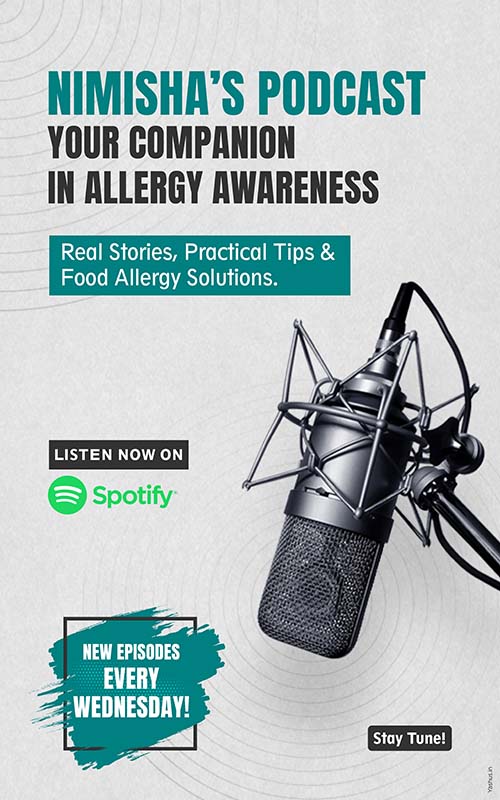Understanding Rare Food Allergies: Symptoms, Diagnosis, and Management Beyond the Common Eight
BlogsDecember 10, 2024

Food allergies are a rising concern globally, with millions of people affected each year. While most individuals are familiar with the top 8 allergens, including milk, eggs, tree nuts, peanuts, soy, wheat, sesame, and shellfish, there exists a wide variety of less common, but equally dangerous, food allergies. These rare allergies often lead to symptoms of an allergic reaction to food and pose a challenge to identify and manage effectively. In this blog, we explore the world of rare food allergies, their causes, food allergy symptoms, diagnosis, and the unique challenges they pose.
The Scope of Rare Food Allergies

Rare food allergies are defined as allergies that affect a smaller population segment than the most common allergens. While data on these allergies is scarce, they may affect around 5-10% of people worldwide. Examples include reactions to fruits like bananas and avocados, vegetables such as celery, or proteins like mustard. These conditions often lead to food intolerance symptoms or skin allergies that can be misdiagnosed.
Some individuals experience food allergies and skin rashes, particularly due to cross-reactivity between food proteins and environmental allergens. For instance, people with birch pollen allergies may experience symptoms of allergic reaction to food like apples or cherries due to similar protein structures. These mechanisms highlight the complexity of types of food allergies and their symptoms.
Causes and Mechanisms Behind Rare Food Allergies
Much like the common food allergies, rare allergies occur when the immune system mistakes certain proteins for harmful invaders, resulting in symptoms such as rashes, digestive issues, or anaphylaxis. This process can cause signs of an allergic reaction to food, including breathing difficulties, hives, or swelling.
For some individuals, genetic predispositions play a role. A family history of dairy allergy, wheat allergy, or peanut allergy symptoms increases the likelihood of rare allergies. Additionally, conditions like Oral Allergy Syndrome (OAS) may manifest in response to specific foods. Environmental factors and exposure to certain foods early in life can also contribute to allergic reaction symptoms.

Symptoms and Challenges in Diagnosis
The symptoms of rare food allergies range from mild discomfort to severe reactions. These may include egg allergy symptoms, milk allergy rash, or digestive issues mimicking gluten intolerance symptoms. In extreme cases, anaphylaxis may occur, requiring immediate treatment.
Diagnosing these allergies is challenging. Many individuals mistake their reactions for food intolerance rather than an allergy, as the symptoms may develop hours or days later. Furthermore, testing for food allergy symptoms in rare allergens is less common. While tests like food allergy testing or food sensitivity tests exist for widespread allergens, those with rare allergies often rely on observation to identify allergens in food.
Tips for Managing Rare Allergies
Packaged Foods

-
Read Ingredient Labels Carefully
Ingredients in packaged goods can sometimes hide rare allergens under broad terms like "natural flavors" or "spices." Individuals with nut allergy symptoms, dairy intolerance symptoms, or a sesame seed allergy should always verify ingredient lists for potential hidden triggers. For example, sesame can appear as “tahini,” “sesame oil,” or even within unspecified "seasoning blends." Familiarity with these terms is crucial to avoiding reactions. -
Check for Cross-Contamination Warnings
Packaged food often carries warnings such as “may contain traces of…” or “produced in a facility that processes…” These warnings are especially important for individuals managing dairy intolerance, nut allergy symptoms, or shellfish allergy symptoms, as cross-contact may result in serious allergic reactions. -
Familiarize Yourself with Alternate Names and Derivatives
Rare allergens often come under different names or derivatives. For example, someone with a sesame seed allergy should recognize terms like “tahini” or “spices,” and those with a wheat allergy need to identify ingredients like “hydrolyzed wheat protein.” Learning to spot these aliases in ingredient lists can significantly reduce the risk of exposure. -
Look for Certifications and Contact Manufacturers
Some packaged food brands provide certifications for allergen-free products. While these often target common allergens, specialty brands may offer options free of rare allergens like sesame or tree nuts. If you're unsure, don’t hesitate to reach out to manufacturers for clarification.
Dining Out

-
Communicate Clearly with Restaurant Staff
It’s vital to notify restaurant staff about specific allergies, whether they are common or rare, such as a tree nut allergy, gluten intolerance, or milk allergy symptoms. Provide clear instructions about your dietary restrictions and emphasize the importance of avoiding cross-contact with allergenic foods during preparation. -
Ask Specific Questions About Ingredients and Preparation Methods
Instead of general inquiries about allergens, ask detailed questions, such as whether a dish contains sesame oil, wheat derivatives, or shared utensils for food preparation. For individuals with food allergies and rashes or other symptoms, understanding these details can prevent accidental exposure. -
Request Modifications or Substitutions
If a dish contains potential allergens, ask whether it can be prepared differently or substituted with safe ingredients. Many restaurants are happy to accommodate requests, such as omitting dairy for those with dairy allergy or replacing gluten-containing ingredients for those with gluten intolerance symptoms. -
Carry Emergency Medication at All Times
Even with thorough precautions, accidents can occur. If you have severe allergies, such as a peanut allergy or shellfish allergy, carrying an epinephrine injector can save your life. Inform dining companions and restaurant staff about the medication and the steps to take in case of a reaction. -
Inquire About Cross-Contamination Practices
Ask whether separate utensils and cooking surfaces are used for allergen-free dishes. This is critical for individuals managing symptoms of allergic reaction to food, such as those caused by egg allergy symptoms or milk protein allergy. Restaurants that follow strict food safety protocols are less likely to expose diners to allergens.
Conclusion
Rare food allergies, while less prevalent than the common allergies, require heightened awareness and care. Understanding signs of dairy intolerance, tree nut allergy symptoms, or foods that cause eczema helps individuals navigate daily life more safely. With better food allergy treatment options, improved labeling, and education, managing even the rarest allergies can become more accessible. By going beyond the top food allergens, we create a safer environment for everyone affected by food allergies.
Explore Allergen-Free Recipes perfect for managing food intolerances and allergies.
FAQ
-
Common food allergies include peanuts, tree nuts, shellfish, dairy products, eggs, and wheat. These allergens cause a wide range of food allergies symptoms, from mild rashes to severe reactions like anaphylaxis. Understanding these top food allergens is c

-
Symptoms of allergic reaction to food vary but typically include hives, swelling, digestive discomfort, and in severe cases, difficulty breathing or anaphylaxis. Food allergies symptoms like skin rashes or food skin allergy can also occur. Recognizing the

-
Food allergy testing involves a series of diagnostic methods, including skin prick tests and blood tests to measure food sensitivity. An experienced food allergist can help determine which specific allergens are triggering your reactions. Food allergy and

-
While both food allergies and food intolerance involve adverse reactions to food, food allergies trigger an immune response, often leading to severe symptoms, such as an allergic reaction from food symptoms like anaphylaxis. In contrast, food intolerance

-
To avoid rare food allergens, carefully read ingredient labels and check for hidden allergens such as mustard, kiwi, or sesame. Pay attention to cross-contamination warnings and ask about food allergy treatment options in restaurants. Identifying these al













